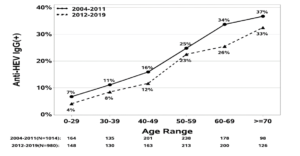Establishing a diagnosis of idiosyncratic drug induced liver injury (DILI) is challenging due to the need to exclude more common causes of acute liver injury such as viral hepatitis, pancreaticobiliary disease, and alcohol. However, acute HEV infection can rarely cause acute viral hepatitis but the frequency with which acute HEV is identified in North American patients with suspected DILI is not known.
In a recent study led by Dr’s Fontana and Farci, serum samples from 2012 DILI patients enrolled in the ongoing DILIN prospective study from 2004 to 2019 were tested for anti-HEV IgG using an ELISA antibody assay at the NIAID (see https://dilin.org). Overall, anti-HEV IgG was detected in 407 (20%) patients and was significantly associated with increasing patient age and earlier year of enrollment. The median age of the seropositive subjects was more than a decade older than that of the seronegative patients (59.8 vs 48.7 years). The overall prevalence of anti-HEV IgG declined over time suggestive of a cohort effect. There were a total of 18 patients (0.9%) with acute HEV infection with detectable anti-HEV IgM of which 7 had detectable HEV RNA genotype 3. Among acute HEV patients, 83% were men, 89% were Caucasian, 17.1% had HIV infection and the median age was 64.1 years. Six-month follow-up samples demonstrated persistent anti-HEV IgG in 11 patients but none of the patients died of liver failure and only 2 had evidence of chronic liver injury but were HEV-RNA negative. The frequency of acute HEV infection declined from 2.4% to 0.8%, 0.6 % and then 0.2 % during the last 4 years of the study.
These data indicate that the frequency of acute HEV infection masquerading as DILI is declining over time in the US. The declining incidence of acute and prior HEV infection in this large multicenter study suggests that the total burden and reservoir of HEV infection may be decreasing in the United States.

The seroprevalence of anti-HEV IgG was highest in older patients with suspected DILI. However, the overall likelihood of prior HEV infection was consistently lower in the more recently enrolled DILIN patients (’12-’19) compared to the earlier patients (’04-’11) suggestive of a cohort effect.
Read the full article (Am J Gastroenterol. 2022 Jun 10. Online ahead of print): DOI: 10.14309/ajg.0000000000001869
Robert J. Fontana (Biography)
Clinical researcher, University
I am a Professor of Medicine at the University of Michigan, Ann Arbor, Michigan. My research interests include the etiology, outcomes and risk factors for Acute liver failure and idiosyncratic DILI as part of the NIH ALFSG and DILIN Registry Networks, respectively. In collaboration with Dr. Farci from the NIAID we have previously found a very low incidence of sporadic acute HEV genotype 3 infection in patients with ALI and ALF in the US. Our most recent analysis of the DILIN cohort from 2004 to 2020 also shows a declining incidence of acute and prior HEV in patients with suspected DILI.
Patrizia Farci
Basic and clinical researcher, NIAID
I am the Chief of the Hepatic Pathogenesis Section in the Laboratory of Infectious Diseases, National Institute of Allergy and Infectious Diseases at the NIH, Bethesda, Maryland. The major goal of our Section is to conduct translational research to study the pathogenesis of acute and chronic viral hepatitis, which are a major cause of morbidity and mortality worldwide. In collaboration with Dr. Fontana, we are defining the role of HEV infection in cohort of patients with acute ALI and DILI.

